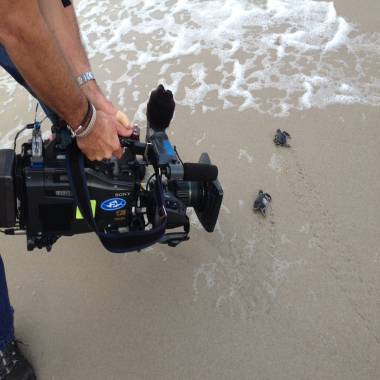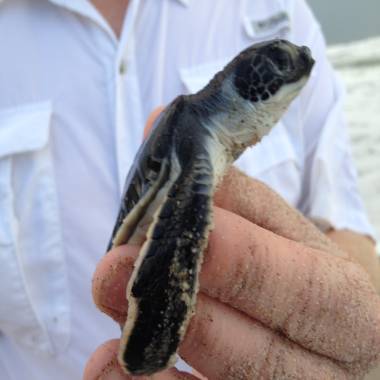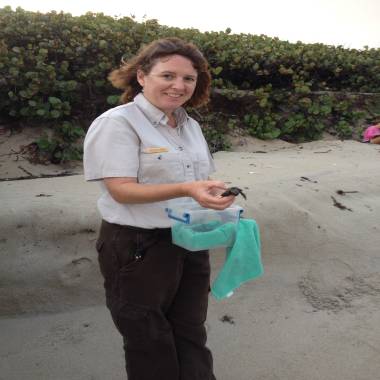Endangered Green Sea Turtles Make a Comeback in Florida
MELBOURNE BEACH, Fla. — When Chris Long thinks back on a summer spent digging up holes in the beach, it’s a job he says he “wouldn’t trade … for anything.”
The 26-year-old University of Central Florida Ph.D. candidate spent months looking for green turtle nests, studying the comeback of a species that — at one time — came dangerously close to extinction.
 Erika Angulo/NBC News
Erika Angulo/NBC News
Photojournalist James Craven captures the journey of two green turtles as they make their way from nest to ocean.
But now, Long and the other biologists at the Archie Carr National Wildlife Refuge in Florida are thrilled by what they found. In 1979 there were only 62 nests in the state, according to the Florida Fish and Wildlife Conservation Commission. This year, there were 35,000.
The campaign to protect green turtles began 35 years ago, when the species was added to the federal list of endangered species.
Eventually, there were bans on the harvesting of eggs, turtle fishing and the sale of sea turtle meat. (Docile, herbivore green turtles, which can grow to weigh more than 400 pounds, were once served as a delicacy at restaurants.)
“It’s astounding that once you stop eating a species it really starts to come back,” said Blair Witherington, Research Scientist at the Florida Fish and Wildlife Conservation Commission. “We almost killed everyone of them, but now they’re coming back.”
 Erika Angulo/NBC News
Erika Angulo/NBC News
A newly hatched green turtle that emerged from one of several new nests on the Florida coast.
It can take green turtles 30 years to mature, which is why scientists are just now seeing the results of the 1978 protective measures. Green turtles lay as many as 200 eggs in a nest and about two months later they start hatching — most of the nests in the continental U.S. are in Florida. Then there is a rush of tiny turtles crawling out of the sandy nests towards the ocean.
“They have to hatch as a group, not only for safety in numbers, but to climb over each other,” said Kristen Kneifl, Research Manager at the Archie Carr National Wildlife Refuge.
Protecting the turtles from man-made threats
One simple measure people can take to help green turtles is to turn off lights near beaches during nesting season, which runs from spring to early fall. Lights from buildings and homes confuse just-hatched turtles, prompting them to crawl towards the bright lights instead of the ocean.
Many Florida beach communities now turn off beach lights during nesting season.
Efforts to restrict beach development, to give green turtles enough space to nest, are also behind the green turtle’s success story. Seawalls built close to the beach threaten turtle nesting.
 Erika Angulo/NBC News
Erika Angulo/NBC News
Kristen Kneifl holds a newly hatched green turtle.
“If you’re going to build a wall along the beach, that means every day, twice a day, at high tide, the whole beach is going to be covered with salt water,” said Llewellyn Ehrhart, a retired University of Central Florida biologist who has spent more than 30 years studying sea turtles.
That sea water can wash away the sand mothers use to cover their eggs according to Ann Marie Lauritsen, national sea turtle coordinator for the U.S. Fish and Wildlife Service. When large amounts of water penetrate the nests it can cause hatchlings to drown before they crawl out.
Despite resurgence, dangers remain
Although much progress has been made to protect the turtles, they still face hazards such as fishing lines and nets; plastic and styrofoam littering the beach; and boaters.
Veterinarians at the Turtle Hospital in Marathon Key, Fla., treat green turtles whose shells were cracked by boats. They use steel roads to re-position the shell in place and keep them in tanks until they heal.
But the biggest health threat facing sea turtles right now, scientists say, is the fibropapillomatosis virus. The disease is similar to herpes, and causes the turtles to grow tumors all over their bodies, including their eyes.
“The tumors are getting more invasive,” said Richie Moretti, director of the Turtle Hospital. “They come in with their whole bodies covered.”
The exact cause of this disease is unknown, but it’s attributed to ocean warming, agricultural runoff and pollution. Ehrhart calls the virus “a drain, a detriment to the population.”
For now, however, conservationists are encouraged by all of the new green turtle nests, something Ehrhart called “phenomenal.”
“It’s just unheard of for a threatened and endangered species,” he said.
To read the original article, click here.
